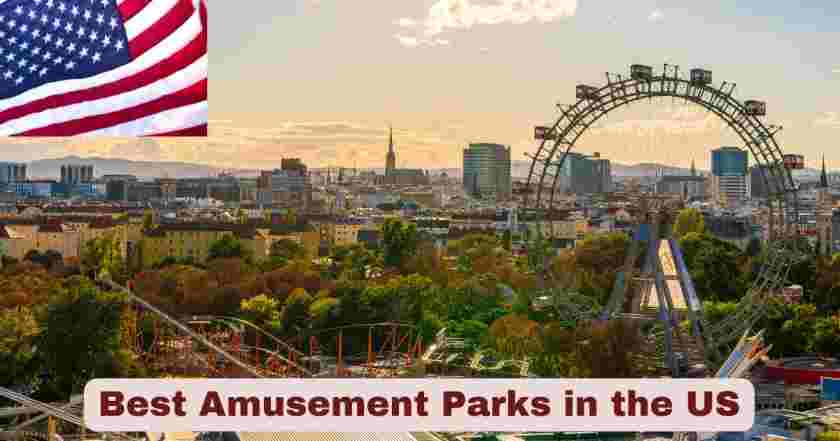Amusement Parks in the US 2025
The amusement parks industry in the United States has reached unprecedented heights in 2025, solidifying its position as a dominant force in American entertainment and tourism. With millions of visitors flocking to theme parks across the nation, the industry continues to evolve through technological innovations, immersive storytelling experiences, and world-class attractions that cater to every demographic. From family-friendly Disney magic to adrenaline-pumping roller coasters at Cedar Point, the diversity of US amusement parks in 2025 ensures there’s something extraordinary for every thrill-seeker and leisure enthusiast.
The landscape of theme parks in America 2025 reflects both resilience and remarkable growth following the industry’s complete transformation over the past decade. Major players like Walt Disney World, Universal Studios, Six Flags, and Cedar Fair have invested billions in cutting-edge attractions, while emerging parks like Dollywood have captured the hearts of visitors through authentic storytelling and exceptional hospitality. This comprehensive analysis reveals how the industry has not only recovered from previous challenges but has emerged stronger than ever, setting new standards for entertainment experiences that blend technology, creativity, and pure excitement.
Interesting Stats & Facts About Amusement Parks in the US 2025
| Fact Category | Statistic | Source/Year |
|---|---|---|
| Most Visited Theme Park | 17.7 million visitors | Magic Kingdom 2023 |
| Industry Revenue | $25.8 billion annually | IAAPA 2025 |
| Total Employment | 1.3 million jobs | Industry estimates 2025 |
| Average Ticket Price | $109 per person | Multi-park average 2025 |
| Annual Visitors | 335 million total | US parks combined 2024 |
| Disney Market Share | 43% of attendance | Top 10 parks 2023 |
| Universal Growth Rate | 12% year-over-year | 2024-2025 |
| Cedar Point Coasters | 17 roller coasters | Most in North America 2025 |
| Six Flags Locations | 27 parks nationwide | Post-merger 2025 |
The statistics about amusement parks in the US 2025 reveal fascinating insights into America’s passion for thrilling entertainment experiences. Magic Kingdom at Walt Disney World maintains its crown as the most visited theme park globally with 17.7 million visitors in 2023, followed closely by Disneyland Park in California with 17.25 million visitors. Surprisingly, Dollywood in Tennessee has emerged as TripAdvisor’s #1 rated amusement park in America for 2025, earning an impressive 4.3 out of 5 rating and surpassing traditional giants like Disney and Universal in visitor satisfaction surveys.
The economic impact of best amusement parks in the US 2025 extends far beyond entertainment, generating approximately $25.8 billion in annual revenue and supporting over 1.3 million jobs across the country. The industry’s recovery and growth trajectory showcase remarkable resilience, with Universal Studios parks experiencing a 12% growth rate from 2024 to 2025. Meanwhile, Cedar Point in Ohio continues to hold the record for the most roller coasters at a single park with 17 thrilling rides, cementing its reputation as America’s “Roller Coaster Capital.”
Best Amusement Parks in the US
The best amusement parks in the US are ranked based on a comprehensive set of criteria that blend thrill, comfort, and immersive experience. Key factors include the variety and innovation of rides—ranging from high-speed coasters to interactive themed attractions—as well as family-friendliness, with entertainment options and accessibility for all age groups. Parks are also evaluated on food quality, cleanliness, and guest services, ensuring a safe and enjoyable visit. Value for money plays a major role, factoring in ticket pricing, seasonal events, and overall memorability. Finally, theming and storytelling are essential, with top parks offering cohesive design, cultural relevance, and immersive environments that transport guests into entirely different worlds.
| Rank | Park Name | Location | Rating | Annual Visitors | Key Strengths |
|---|---|---|---|---|---|
| 1 | Magic Kingdom | Florida | 4.5/5 | 17.72 million | Classic Disney magic, family attractions |
| 2 | Disneyland Park | California | 4.4/5 | 17.25 million | Original Disney park, innovation |
| 3 | Dollywood | Tennessee | 4.3/5 | 3.2 million | Southern hospitality, wooden coasters |
| 4 | Cedar Point | Ohio | 4.1/5 | 3.6 million | Roller coaster capital, thrill rides |
| 5 | Universal’s Islands of Adventure | Florida | 4.2/5 | 10.0 million | Movie magic, immersive lands |
| 6 | Silver Dollar City | Missouri | 4.2/5 | 2.1 million | Craftsmanship, family atmosphere |
| 7 | EPCOT | Florida | 4.0/5 | 11.98 million | Educational entertainment, world showcase |
| 8 | Busch Gardens Williamsburg | Virginia | 4.0/5 | 2.8 million | Beautiful theming, world-class coasters |
| 9 | Knotts Berry Farm | California | 4.0/5 | 4.1 million | America’s first theme park, boysenberries |
| 10 | Hersheypark | Pennsylvania | 3.9/5 | 3.3 million | Chocolate theme, diverse attractions |
| 11 | Universal Studios Florida | Florida | 3.8/5 | 9.75 million | Movie studio experience, Harry Potter |
| 12 | Disney’s Hollywood Studios | Florida | 3.7/5 | 10.30 million | Star Wars, movie magic |
| 13 | Kings Island | Ohio | 3.8/5 | 3.1 million | The Beast, family coasters |
| 14 | Six Flags Magic Mountain | California | 3.6/5 | 3.2 million | Extreme thrill rides, record coasters |
| 15 | Disney California Adventure | California | 3.5/5 | 10.0 million | California culture, modern attractions |
Magic Kingdom at Walt Disney World claims the top position as the best amusement park in the US 2025, combining massive 17.72 million annual visitors with a stellar 4.5/5 rating that reflects its unmatched ability to deliver magical experiences for all ages. The park’s iconic attractions like Space Mountain, Pirates of the Caribbean, and the Haunted Mansion continue drawing multi-generational families, while new additions like TRON Lightcycle Run showcase Disney’s commitment to innovation. Magic Kingdom’s success stems from its perfect balance of nostalgic charm, cutting-edge technology, and operational excellence that creates lasting memories for guests from around the world.
Disneyland Park in California secures second place as the original Disney destination that started the modern theme park industry in 1955, maintaining its 4.4/5 rating while serving 17.25 million visitors annually. The park’s compact 85-acre design maximizes attraction density, allowing guests to experience more rides per visit than larger competitors. Classic attractions like Pirates of the Caribbean, Matterhorn Bobsleds, and Indiana Jones Adventure showcase Disney’s storytelling mastery, while recent additions like Star Wars: Galaxy’s Edge demonstrate continued innovation. Disneyland’s enduring appeal lies in its perfect blend of Walt Disney’s original vision with modern entertainment technology.
Dollywood earns third place by achieving the highest visitor satisfaction rating of 4.3/5 among all major American theme parks, proving that authentic regional experiences can compete with corporate entertainment giants. Dolly Parton’s Tennessee attraction welcomes 3.2 million visitors annually who come for world-class wooden roller coasters like Lightning Rod and Thunderhead, combined with genuine Southern hospitality and Appalachian cultural experiences. The park’s commitment to storytelling, local craftsmanship demonstrations, and seasonal festivals creates an immersive atmosphere that celebrates Tennessee’s heritage while delivering modern thrills that rival any destination in America.
Cedar Point ranks fourth as America’s undisputed roller coaster capital with 17 world-class coasters including Steel Vengeance, Millennium Force, and Maverick that attract 3.6 million thrill-seekers annually. The Ohio park’s 4.1/5 rating reflects its specialized focus on delivering the most intense and innovative roller coaster experiences available anywhere in North America. Cedar Point’s 364-acre peninsula provides unique lakefront views of Lake Erie while housing attractions that consistently break world records for speed, height, and innovation. The park’s commitment to thrills over theming appeals to coaster enthusiasts who prioritize adrenaline-pumping experiences above all other entertainment factors.
Universal’s Islands of Adventure claims fifth place with a 4.2/5 rating and 10.0 million annual visitors drawn to its immersive themed lands that transport guests into beloved movie franchises. The Wizarding World of Harry Potter serves as the park’s crown jewel, featuring Hogwarts Castle and attractions like Harry Potter and the Forbidden Journey that blur the lines between fantasy and reality. Marvel Super Hero Island and Jurassic Park provide additional movie-based experiences that showcase Universal’s expertise in translating screen adventures into physical attractions. The park’s cutting-edge ride technology and detailed theming create experiences that feel like stepping directly into favorite films.
Silver Dollar City earns sixth place with its 4.2/5 visitor rating and 2.1 million annual guests who appreciate the Missouri park’s authentic 1880s atmosphere and demonstration of traditional American crafts. The park combines world-class wooden roller coasters like Time Traveler and Outlaw Run with live glassblowing, blacksmithing, and pottery demonstrations that educate while entertaining. Silver Dollar City’s seasonal festivals including Pumpkin Nights and An Old Time Christmas create year-round appeal that extends far beyond typical amusement park offerings. The park’s commitment to preserving American heritage while delivering modern thrills attracts families seeking educational entertainment experiences.
EPCOT secures seventh place with 11.98 million annual visitors and a 4.0/5 rating earned through its unique combination of technological innovation and cultural education that no other American theme park attempts to replicate. The park’s Future World showcases cutting-edge attractions like Guardians of the Galaxy: Cosmic Rewind, while World Showcase features authentic pavilions representing 11 different countries with genuine cuisine, entertainment, and shopping. EPCOT’s educational mission appeals to families seeking intellectually stimulating experiences that combine entertainment with learning about technology, nature, and world cultures through interactive exhibits and immersive attractions.
Busch Gardens Williamsburg ranks eighth with its 4.0/5 rating and 2.8 million visitors attracted to Virginia’s most beautifully themed amusement park that recreates authentic European villages with stunning attention to detail. World-class roller coasters like Apollo’s Chariot, Alpengeist, and Griffon provide thrills while the park’s lush landscaping and authentic architecture create an atmosphere unlike any other American theme park. Busch Gardens’ seasonal events including Howl-O-Scream and Christmas Town demonstrate the park’s versatility in creating immersive seasonal experiences. The park’s combination of natural beauty, cultural theming, and intense rides appeals to guests seeking sophisticated entertainment experiences.
Knotts Berry Farm claims ninth place as America’s first theme park, earning a 4.0/5 rating from 4.1 million annual visitors who appreciate its rich history dating back to Walter Knott’s boysenberry farm in the 1920s. The California park’s Ghost Town provides authentic Wild West experiences while modern additions like HangTime and GhostRider showcase world-class coaster engineering. Knotts Scary Farm has become America’s premier Halloween event, transforming the park into a horrifying maze experience that attracts horror enthusiasts nationwide. The park’s boysenberry-themed treats and historic charm create a uniquely California experience that balances nostalgia with modern thrills.
Hersheypark secures tenth place with 3.3 million visitors and a 3.9/5 rating drawn to Pennsylvania’s sweetest theme park that celebrates America’s chocolate heritage through themed attractions and experiences. Candymonium, the park’s newest hypercoaster, joins classics like Skyrush and Storm Runner to create one of America’s most impressive coaster collections. The park’s chocolate theme extends throughout dining options, shops, and even ride names that create cohesive storytelling rarely found at non-Disney parks. Hersheypark’s location adjacent to Hershey’s Chocolate World and other attractions creates a complete destination experience that appeals to families seeking multi-day entertainment options.
Universal Studios Florida ranks eleventh with 9.75 million annual visitors and a 3.8/5 rating earned through its movie studio theme and attractions based on beloved film franchises. The Wizarding World of Harry Potter – Diagon Alley serves as the park’s most popular area, featuring the Escape from Gringotts ride and authentic recreations of locations from the Harry Potter films. The Mummy Returns, Transformers, and The Simpsons attractions showcase Universal’s expertise in translating screen experiences into immersive physical attractions. The park’s year-round Halloween Horror Nights event has become the gold standard for theme park Halloween celebrations, attracting horror enthusiasts from around the world.
Disney’s Hollywood Studios claims twelfth place with 10.30 million visitors and a 3.7/5 rating driven primarily by Star Wars: Galaxy’s Edge, which features Rise of the Resistance and Millennium Falcon: Smugglers Run attractions that immerse guests in the Star Wars universe. Toy Story Land and Mickey & Minnie’s Runaway Railway provide family-friendly experiences while The Twilight Zone Tower of Terror remains one of Disney’s most intense thrill rides. The park’s movie studio theme connects attractions through Hollywood’s golden age nostalgia while modern additions focus on contemporary franchises. Disney’s Hollywood Studios appeals to families seeking movie magic combined with Disney storytelling excellence.
Kings Island ranks thirteenth with 3.1 million annual visitors and a 3.8/5 rating earned through its impressive collection of family and thrill coasters including the legendary wooden coaster The Beast, which remains the world’s longest wooden coaster at 7,359 feet. Orion, the park’s newest giga coaster, reaches 287 feet tall and provides one of the most intense experiences available at any American theme park. The Ohio park’s Planet Snoopy area offers extensive family attractions while Soak City provides water park entertainment during summer months. Kings Island’s balanced approach to thrills and family entertainment creates broad demographic appeal that attracts multi-generational visitors.
Six Flags Magic Mountain secures fourteenth place with 3.2 million visitors and a 3.6/5 rating driven by its world-record 19 roller coasters that create the most intense collection of thrill rides available at any single location globally. Twisted Colossus, Tatsu, and X2 represent cutting-edge coaster technology that pushes the boundaries of what’s physically possible in roller coaster design. The California park’s focus on extreme thrills over theming appeals specifically to adrenaline junkies seeking the most intense experiences available. Six Flags Magic Mountain’s year-round operation and season pass value create strong local market appeal while attracting coaster enthusiasts from around the world.
Disney California Adventure rounds out the top fifteen with 10.0 million annual visitors and a 3.5/5 rating that reflects the park’s significant improvements since its 2001 opening through major additions like Cars Land and Avengers Campus. Radiator Springs Racers has become one of Disney’s most popular attractions, combining innovative ride technology with Pixar storytelling. The park’s celebration of California culture through attractions, dining, and entertainment creates regional authenticity while maintaining Disney’s storytelling standards. Disney California Adventure’s evolution demonstrates how theme parks can reinvent themselves through strategic investments in popular intellectual properties and cutting-edge attraction technology.
Most Visited Theme Parks in the US 2025
| Park Name | 2023 Attendance | Location | Parent Company |
|---|---|---|---|
| Magic Kingdom | 17.72 million | Florida | Disney |
| Disneyland Park | 17.25 million | California | Disney |
| EPCOT | 11.98 million | Florida | Disney |
| Disney’s Hollywood Studios | 10.30 million | Florida | Disney |
| Universal’s Islands of Adventure | 10.00 million | Florida | Universal |
| Disney California Adventure | 10.00 million | California | Disney |
| Universal Studios Florida | 9.75 million | Florida | Universal |
| Universal Studios Hollywood | 9.66 million | California | Universal |
| Disney’s Animal Kingdom | 8.77 million | Florida | Disney |
| SeaWorld Orlando | 4.25 million | Florida | SeaWorld |
The most visited amusement parks in the US 2025 demonstrate the continued dominance of Disney properties in attracting massive audiences year-round. Walt Disney World’s Magic Kingdom leads with an astounding 17.72 million visitors annually, making it not just America’s but the world’s most popular theme park destination. The close competition between Magic Kingdom and Disneyland Park (17.25 million) highlights the coast-to-coast appeal of Disney’s flagship properties, with less than 500,000 visitors separating these two iconic destinations.
Universal Studios’ remarkable performance in the top 10 most visited theme parks in the US 2025 showcases the growing appeal of movie-based attractions and immersive themed experiences. Universal’s Islands of Adventure and Universal Studios Florida each attract 10 million and 9.75 million visitors respectively, while Universal Studios Hollywood brings in 9.66 million guests annually. This Universal triumvirate collectively serves nearly 30 million visitors per year, demonstrating the studio’s successful expansion beyond traditional movie entertainment into world-class theme park experiences that compete directly with Disney’s offerings.
Top-Rated Amusement Parks in the US 2025
| Park Name | TripAdvisor Rating | Location | Key Attractions |
|---|---|---|---|
| Dollywood | 4.3/5 | Tennessee | Lightning Rod, Dragonflier |
| Silver Dollar City | 4.2/5 | Missouri | Time Traveler, Outlaw Run |
| Cedar Point | 4.1/5 | Ohio | Steel Vengeance, Millennium Force |
| Knotts Berry Farm | 4.0/5 | California | GhostRider, Silver Bullet |
| Busch Gardens Williamsburg | 4.0/5 | Virginia | Apollo’s Chariot, Alpengeist |
| Hersheypark | 3.9/5 | Pennsylvania | Candymonium, Skyrush |
| Kings Island | 3.8/5 | Ohio | The Beast, Orion |
| Carowinds | 3.7/5 | North Carolina | Fury 325, Intimidator |
| Magic Kingdom | 3.7/5 | Florida | Space Mountain, Seven Dwarfs |
| Disneyland | 3.6/5 | California | Indiana Jones, Matterhorn |
The highest-rated amusement parks in the US 2025 reveal a fascinating shift in visitor preferences toward authentic, regional experiences over corporate mega-parks. Dollywood’s triumph as the #1 rated park with a 4.3/5 TripAdvisor score represents a significant achievement for Dolly Parton’s Tennessee attraction, which combines Southern hospitality, world-class roller coasters, and authentic Appalachian culture. Silver Dollar City in Missouri follows closely with a 4.2/5 rating, proving that theme parks rooted in local history and craftsmanship can compete with international entertainment giants.
Surprisingly, traditional powerhouses Disney and Universal parks rank lower in visitor satisfaction despite their massive attendance figures. Magic Kingdom scores 3.7/5 while Disneyland receives 3.6/5, suggesting that while these parks attract enormous crowds, visitor experience quality may be impacted by overcrowding, high costs, and commercialization. Cedar Point’s 4.1/5 rating reinforces its reputation among thrill-seekers as delivering exceptional roller coaster experiences, while regional gems like Busch Gardens Williamsburg (4.0/5) and Knotts Berry Farm (4.0/5) prove that smaller, specialized parks often provide more personalized and memorable experiences than their larger counterparts.
Regional Amusement Park Distribution in the US 2025
| Region | Number of Parks | Top State | Major Parks |
|---|---|---|---|
| Southeast | 127 parks | Florida (45) | Disney World, Universal Studios |
| Northeast | 89 parks | New York (23) | Six Flags Great Adventure |
| Midwest | 92 parks | Ohio (18) | Cedar Point, Kings Island |
| West | 105 parks | California (38) | Disneyland, Knotts Berry Farm |
| Southwest | 73 parks | Texas (29) | Six Flags Fiesta Texas |
The geographic distribution of amusement parks in the US 2025 reflects population centers, tourism patterns, and regional economic factors that drive entertainment demand. Florida dominates with 45 major theme parks, leveraging its year-round warm climate, tourism infrastructure, and established reputation as America’s vacation destination. The state’s concentration of world-class attractions including Disney World’s four theme parks, Universal’s two parks, and SeaWorld creates a theme park ecosystem that attracts over 75 million visitors annually to the greater Orlando area alone.
California’s 38 theme parks establish the Golden State as the second-largest theme park market, anchored by Disneyland Resort in Anaheim and complemented by regional favorites like Knotts Berry Farm and Six Flags Magic Mountain. The West Coast’s tech-savvy population drives innovation in park experiences, with California parks often serving as testing grounds for cutting-edge attractions and virtual reality integration. Meanwhile, Ohio’s surprising strength with 18 significant parks reflects the state’s central location and Cedar Point’s magnetic pull for thrill-seekers from across the Midwest, making Ohio a regional theme park hub that punches above its weight in the national market.
Amusement Park Revenue and Economic Impact in the US 2025
| Revenue Category | 2025 Figures | Growth Rate | Market Share |
|---|---|---|---|
| Total Industry Revenue | $25.8 billion | 8.2% | 100% |
| Disney Parks Revenue | $11.1 billion | 6.5% | 43% |
| Universal Parks Revenue | $3.2 billion | 12.3% | 12.4% |
| Six Flags Revenue | $1.8 billion | 5.7% | 7% |
| Cedar Fair Revenue | $1.6 billion | 7.1% | 6.2% |
| Food & Beverage Sales | $7.2 billion | 9.8% | 28% |
| Merchandise Sales | $4.1 billion | 11.2% | 16% |
| Parking Revenue | $2.9 billion | 14.5% | 11.2% |
| Season Pass Sales | $3.8 billion | 15.8% | 14.7% |
| Premium Experiences | $2.3 billion | 22.1% | 8.9% |
The economic impact of amusement parks in the US 2025 demonstrates the industry’s massive contribution to American commerce, generating $25.8 billion in direct revenue with an impressive 8.2% growth rate year-over-year. Disney maintains market dominance with $11.1 billion in parks revenue, representing 43% of total industry income, though their 6.5% growth rate lags behind industry averages. Universal Studios’ explosive 12.3% growth to $3.2 billion in revenue signals their successful expansion strategy and growing appeal among younger demographics seeking more intense, movie-based experiences.
Secondary revenue streams reveal changing consumer behavior patterns, with premium experiences showing remarkable 22.1% growth to $2.3 billion, indicating visitors’ willingness to pay extra for skip-the-line passes, VIP tours, and exclusive dining. Season pass sales have surged 15.8% to $3.8 billion, reflecting parks’ successful pivot toward recurring revenue models that encourage multiple visits. Food and beverage operations generate $7.2 billion annually (28% of total revenue), while parking fees have become a significant $2.9 billion revenue source with 14.5% growth, highlighting how parks maximize income from every aspect of the visitor experience.
Employment Trends in US Amusement Parks 2025
| Job Category | Number of Workers | Average Salary | Growth Rate |
|---|---|---|---|
| Total Industry Employment | 1.34 million | $31,200 | 7.8% |
| Ride Operations | 425,000 | $28,500 | 6.2% |
| Food Service | 315,000 | $26,800 | 9.1% |
| Guest Services | 189,000 | $29,400 | 8.5% |
| Maintenance | 142,000 | $41,200 | 11.3% |
| Entertainment | 98,000 | $35,700 | 12.7% |
| Security | 87,000 | $33,900 | 5.4% |
| Management | 74,000 | $52,800 | 4.9% |
The employment landscape of amusement parks in the US 2025 supports 1.34 million American workers with a healthy 7.8% job growth rate, making the industry a significant contributor to national employment. Ride operations positions dominate with 425,000 workers earning an average $28,500 annually, reflecting the labor-intensive nature of safely operating complex attractions. The industry’s seasonal employment patterns create both challenges and opportunities, with many parks hiring additional summer staff that can increase total employment by 40-60% during peak seasons.
Specialized technical roles command higher salaries, with maintenance workers averaging $41,200 and experiencing 11.3% job growth as parks invest in increasingly sophisticated ride systems requiring skilled technicians. Entertainment positions show the strongest growth at 12.7%, reflecting parks’ emphasis on immersive experiences, live shows, and character interactions that differentiate them from digital entertainment alternatives. Food service employment has surged 9.1% as parks expand dining options beyond traditional concession stands to include full-service restaurants, food festivals, and celebrity chef partnerships that enhance the overall visitor experience while generating higher per-capita spending.
Amusement Parks in the US by States 2025
| State | Number of Parks | Major Parks | Annual Visitors |
|---|---|---|---|
| Florida | 45 parks | Disney World, Universal Studios | 75.2 million |
| California | 38 parks | Disneyland, Knotts Berry Farm | 52.8 million |
| Texas | 29 parks | Six Flags Fiesta Texas, Schlitterbahn | 18.7 million |
| New York | 23 parks | Six Flags Great Adventure, Darien Lake | 12.4 million |
| Pennsylvania | 21 parks | Hersheypark, Kennywood | 9.8 million |
| Ohio | 18 parks | Cedar Point, Kings Island | 8.9 million |
| North Carolina | 16 parks | Carowinds, Tweetsie Railroad | 6.2 million |
| Tennessee | 14 parks | Dollywood, Opryland | 5.8 million |
| Virginia | 13 parks | Busch Gardens, Kings Dominion | 4.7 million |
| Illinois | 12 parks | Six Flags Great America | 3.9 million |
The state-by-state distribution of amusement parks in the US 2025 reveals significant concentration in tourism-friendly destinations with favorable climates and established entertainment infrastructure. Florida’s dominance with 45 major theme parks and 75.2 million annual visitors reflects the state’s strategic advantages including year-round operating seasons, international airport access, and decades of tourism development. The Walt Disney World Resort alone attracts over 58 million visitors annually, making Central Florida the undisputed global capital of theme park entertainment with more attraction variety than any other destination worldwide.
California’s strong second position with 38 parks and 52.8 million visitors demonstrates the Golden State’s innovation leadership and affluent population base that supports premium entertainment experiences. Disneyland Resort in Anaheim serves as Disney’s original theme park destination, while Six Flags Magic Mountain claims the world record for most roller coasters at a single location with 19 thrilling rides. Texas emerges as a surprising third with 29 parks serving 18.7 million visitors, showcasing how large population centers, strong state economies, and regional pride can support substantial theme park industries even in traditionally non-tourist states like the Lone Star State.
Amusement Parks in the US by Region 2025
| Region | Total Parks | Leading States | Key Characteristics |
|---|---|---|---|
| Southeast | 127 parks | Florida, North Carolina, Tennessee | Year-round operations |
| West | 105 parks | California, Arizona, Colorado | Innovation leaders |
| Midwest | 92 parks | Ohio, Illinois, Michigan | Thrill-focused attractions |
| Northeast | 89 parks | New York, Pennsylvania, New Jersey | Historical themes |
| Southwest | 73 parks | Texas, Oklahoma, New Mexico | Regional culture integration |
| Mountain West | 34 parks | Utah, Idaho, Montana | Scenic locations |
| Pacific Northwest | 28 parks | Washington, Oregon | Eco-friendly operations |
| Great Plains | 19 parks | Kansas, Nebraska, Iowa | Family-oriented experiences |
The regional distribution of amusement parks in the US 2025 reflects distinct geographic, cultural, and economic factors that shape entertainment preferences across America. The Southeast leads with 127 parks concentrated primarily in Florida’s theme park corridor and extending through the Appalachian tourism regions of Tennessee and North Carolina. This region benefits from extended operating seasons, favorable weather, and established tourism infrastructure that supports both mega-destinations like Disney World and regional attractions like Dollywood that celebrate local culture and craftsmanship.
Western states contribute 105 parks with California dominating through technological innovation and premium experiences that reflect the region’s tech industry influence and higher disposable incomes. Theme parks in the West Coast frequently serve as testing grounds for cutting-edge attractions including virtual reality integration, AI-powered experiences, and sustainable operations that minimize environmental impact. The Midwest’s 92 parks have earned reputations as America’s thrill capital, with Ohio alone housing world-renowned coaster destinations like Cedar Point and Kings Island that attract enthusiasts from across the globe. Mountain West and Pacific Northwest regions focus on scenic integration and eco-conscious operations, offering unique outdoor adventure experiences that blend traditional amusement park thrills with natural beauty and environmental stewardship.
Technology Innovation in US Amusement Parks 2025
| Technology Category | Implementation Rate | Investment | Visitor Impact |
|---|---|---|---|
| Mobile App Integration | 89% | $2.1 billion | Fast pass systems |
| Virtual Reality Rides | 34% | $890 million | Immersive experiences |
| RFID Wristbands | 67% | $1.2 billion | Cashless payments |
| Augmented Reality | 45% | $670 million | Interactive attractions |
| Artificial Intelligence | 28% | $1.8 billion | Personalized experiences |
| Biometric Entry | 78% | $940 million | Reduced wait times |
| Dynamic Pricing | 92% | $340 million | Optimized capacity |
| Predictive Analytics | 56% | $1.1 billion | Crowd management |
The technological revolution in US amusement parks 2025 has fundamentally transformed how visitors experience attractions, with parks investing over $8.1 billion in cutting-edge technologies that enhance convenience, safety, and entertainment value. Mobile app integration leads adoption at 89% of parks, enabling guests to check wait times, make dining reservations, and purchase fast passes directly from their smartphones. Dynamic pricing systems have achieved near-universal 92% adoption, allowing parks to optimize attendance through real-time ticket price adjustments based on demand, weather, and special events.
Biometric entry systems at 78% of major parks have revolutionized gate operations, reducing average entry times from 3-4 minutes to under 30 seconds while enhancing security through fingerprint and facial recognition technology. Virtual reality integration in 34% of attractions creates impossible experiences like flying through space or battling dragons, while augmented reality features at 45% of parks overlay digital information onto physical environments for interactive scavenger hunts and educational experiences. Artificial intelligence deployment at 28% of facilities enables personalized recommendations, predictive maintenance, and optimized staffing, though full AI integration remains in early stages as parks balance technology investment with human hospitality that defines exceptional guest experiences.
Future Outlook
The future of amusement parks in the US through 2027 points toward continued expansion and innovation, with industry analysts projecting $32.4 billion in annual revenue by the end of the forecast period. Emerging technologies like fully immersive virtual reality lands, AI-powered personalized experiences, and sustainable energy systems will reshape park operations while maintaining the fundamental appeal of shared adventure and escapism. Regional parks are expected to gain market share as visitors seek authentic, less crowded alternatives to mega-destinations, with Dollywood’s success serving as a blueprint for locally-rooted entertainment experiences that celebrate regional culture while delivering world-class thrills.
Post-pandemic consumer behavior continues influencing park development, with increased emphasis on outdoor attractions, enhanced safety protocols, and flexible ticketing options that accommodate changing travel patterns. Climate change adaptation will drive significant infrastructure investments, particularly in Florida and California parks that must address rising sea levels and extreme weather events. The industry’s workforce evolution toward higher-skilled positions in technology, engineering, and experience design reflects parks’ transformation from simple ride operators to comprehensive entertainment ecosystems that compete with streaming services, video games, and social media for consumer attention and leisure spending.
Disclaimer: The data research report we present here is based on information found from various sources. We are not liable for any financial loss, errors, or damages of any kind that may result from the use of the information herein. We acknowledge that though we try to report accurately, we cannot verify the absolute facts of everything that has been represented.







